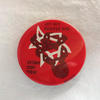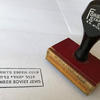2: Vintage Soviet Jewry Movement stationary stamp and pin, 1970s-1980s.
Physical objects from the era of the Soviet Jewry Movement can help to contextualize the story. Included here are images of a pin with the phrase “Let my people go” and a stamp embossed with the words “Remember Soviet Jews.” In both cases the text is in English and Hebrew, though the stamp additionally includes Russian (both the Hebrew and the Russian translations on the stamp contain grammatical inaccuracies). These objects and others were collected, worn, used, and displayed by American Jews who were concerned about the plight of Soviet Jews. The Hebrew-language shalakh et ’ami, from the biblical Book of Exodus, is God’s command to the pharaoh to let the people of Israel leave Egypt. Its English translation, besides being known to most Jews in North America through the annual retelling of the Exodus story during Passover, has come to be identified in the broader American culture—through the words of a spiritual famously performed by the likes of Paul Robeson and Louis Armstrong—with the struggle for the civil rights of African Americans in the twentieth century.
Suggested Activity: Consider the pin and the stamp. What do objects like these say about how their American owners imagined Soviet Jews? Think about the multilingual statements on these objects: What would wearing such a pin to a meeting or protest (or, perhaps, in everyday life) or using the stamp on one’s personal correspondence communicate to others? How might it shape the identities of those who owned and used these items?
Source: “Let my people go” pin and “Remember Soviet Jews” stationary stamp. From the personal collection of Sasha Senderovich; these objects belonged to Norman (z”l) and Minna Halperin of Springfield, Massachusetts.


